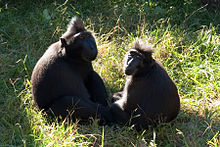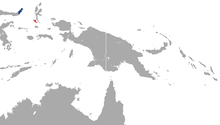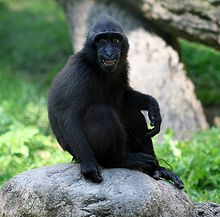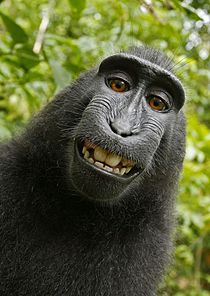- Celebes crested macaque
-
Celebes Crested macaque[1] 
Conservation status Scientific classification Kingdom: Animalia Phylum: Chordata Class: Mammalia Order: Primates Family: Cercopithecidae Genus: Macaca Species: M. nigra Binomial name Macaca nigra
(Desmarest, 1822)
Celebes Crested Macaque range
(blue — native, red — introduced)The Celebes crested macaque (Macaca nigra), also known as the crested black macaque, Sulawesi crested macaque, or the black ape, is an Old World monkey that lives in the northeast of the Indonesian island of Sulawesi (Celebes) as well as on smaller neighboring islands.
Its skin and hairless face is, with the exception of some white hair in the shoulder range, entirely jet black. The long muzzle with high cheeks and the long hair tuft, or crest, at the top side of the head are remarkable. The tail is only approximately 2 cm (1 in) of stub. With a total body length of 45 cm (18 in) to 60 cm (24 in) and a weight of 7 to 10 kg, it is one of the smaller macaque species.
The Celebes crested macaque is a diurnal rain forest dweller. This macaque is primarily terrestrial, spending more than 60% of its day on the ground foraging for food and socializing, while sleeping and searching for food in the trees.
It lives in groups of 5 to 25 animals. Smaller groups have only a single male, while larger groups have up to four males. The females, however, always outnumber the males by about 4:1. Since young males must leave their birth group upon maturity, they sometimes form bachelor groups before they look for a connection to an existing mixed group. Communication consists of various sounds and gestures; such as the presentation of the long eyeteeth while grimacing a clear threatening gesture.
The Celebes crested macaque is frugivorous, with 70% of its diet consisting of fruits. It also consumes leaves, buds, seeds, fungus, birds and bird eggs, insects (such as caterpillars), and the occasional small lizard or frog.
The Celebes crested macaque is promiscuous, with both males and females mating multiple times with multiple partners. The receptivity of the females is clearly indicated by an extreme tumescence (swelling) and redness of their buttocks which, in contrast to the black skin color, is particularly remarkable. The gestation time is 174 days, and the birth of the usually single offspring happens in the spring when food is more plentiful. Young animals are nursed approximately one year and become fully mature in 3 to 4 years, females somewhat sooner than males. Its life expectancy is estimated at approximately 20 years.
Because it devastates crops and fields, the Celebes crested macaque is hunted as a pest. It is also hunted to provide bushmeat. Clearing the rain forests further threatens its survival. Its situation on the small neighbouring islands of Sulawesi (such as Bacan) is somewhat better, since these have a low human population. The total population of the macaque on Sulawesi is estimated at 4,000-6,000, while a booming population of up to 100,000 monkeys is found on Bacan.
A recent series of survey trips to Sulawesi and the Minehasa forest area have been made in 2004-2009 by Vicki Melfi, who is EEP studbook holder for these macaques, based at Paignton Zoo / the Whitley Wildlife Conservation Trust. She has been monitoring population density which has declined from over 300 individuals per square kilometre in 1980 to 20 to 60 individuals today. A conservation programme Selamatkan Yaki - or 'Save the Yaki' as this macaque is known in the local language - has been launched with local partners and other conservation groups from Thailand, Germany and the Wildlife Conservation Society (based in USA). Both Newquay Zoo and Paignton Zoo are among a number of mostly European zoos which hold ex-situ breeding populations of this animal.[3]
Since 2006, the Macaca Nigra Project studies the biology and promotes the conservation of this species. The project, a collaboration between the German Primate Center and the Bogor Agricultural Institute, run by Antje Engelhardt, is located in the Tangkoko reserve, home of the biggest crested macaque population remaining in the species' original distribution range.
References
- ^ Groves, C. (2005). Wilson, D. E., & Reeder, D. M, eds. ed. Mammal Species of the World (3rd ed.). Baltimore: Johns Hopkins University Press. pp. 163. OCLC 62265494. ISBN 0-801-88221-4. http://www.bucknell.edu/msw3/browse.asp?id=12100553.
- ^ Supriatna, J. & Andayana, N. (2008). Macaca nigra. In: IUCN 2008. IUCN Red List of Threatened Species. Downloaded on 4 January 2009.
- ^ Selamatkan Yaki! article in Zoo News (Whitley Wildlife Conservation Trust newsletter), Issue 69, Autumn 2009, p. 16.
External links
- ARKive - images and movies of the crested black macaque (Macaca nigra)
- Primate Info Net Macaca nigra Factsheet
- The Macaca Nigra Project
Categories:- IUCN Red List critically endangered species
- Mammals of Asia
- Mammals of Indonesia
- Cercopithecine monkeys
- Animals described in 1822
Wikimedia Foundation. 2010.



